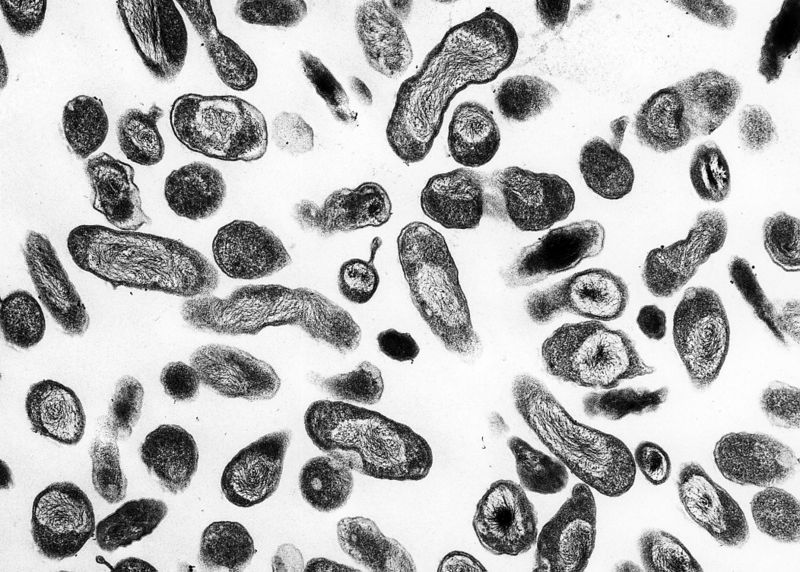Q fever pathophysiology: Difference between revisions
No edit summary |
No edit summary |
||
| Line 2: | Line 2: | ||
{{CMG}} | {{CMG}} | ||
{{Q fever}} | {{Q fever}} | ||
==Pathophysiology== | |||
Cattle, sheep, and goats are the primary reservoirs of C. burnetii. Infection has been noted in a wide variety of other animals, including other species of livestock and in domesticated pets. Coxiella burnetii does not usually cause clinical disease in these animals, although abortion in goats and sheep has been linked to C. burnetii infection. Organisms are excreted in milk, urine, and feces of infected animals. Most importantly, during birthing the organisms are shed in high numbers within the amniotic fluids and the placenta. The organisms are resistant to heat, drying, and many common disinfectants. These features enable the bacteria to survive for long periods in the environment. Infection of humans usually occurs by inhalation of these organisms from air that contains airborne barnyard dust contaminated by dried placental material, birth fluids, and excreta of infected herd animals. Humans are often very susceptible to the disease, and very few organisms may be required to cause infection. | |||
[[Image:Coxiella burnetii.JPG|thumb|left|C. burnetii, the Q fever causing agent]] | |||
Ingestion of contaminated milk, followed by regurgitation and inspiration of the contaminated food, is a less common mode of transmission. Other modes of transmission to humans, including tick bites and human to human transmission, are rare. | Ingestion of contaminated milk, followed by regurgitation and inspiration of the contaminated food, is a less common mode of transmission. Other modes of transmission to humans, including tick bites and human to human transmission, are rare. | ||
Some animals can pass Q fever to people. Cattle, sheep, and goats are most likely to carry C. burnetii, but other kinds of animals can also have this disease. Most infected animals do not show signs of Q fever, but the organism can be in barnyard dust that contains manure, urine or dried fluids from the births of calves or lambs. People usually get Q fever by breathing in this contaminated barnyard dust. Occasionally, people can get Q fever from drinking contaminated milk or from tick bites. | |||
==References== | ==References== | ||
{{Reflist|2}} | {{Reflist|2}} | ||
[[Category: | [[Category:Needs overview]] | ||
[[Category:Infectious disease]] | [[Category:Infectious disease]] | ||
[[Category:Bacterial diseases]] | [[Category:Bacterial diseases]] | ||
Revision as of 15:39, 6 December 2012
Editor-In-Chief: C. Michael Gibson, M.S., M.D. [1]
|
Q fever Microchapters |
|
Diagnosis |
|---|
|
Treatment |
|
Case Studies |
|
Q fever pathophysiology On the Web |
|
American Roentgen Ray Society Images of Q fever pathophysiology |
|
Risk calculators and risk factors for Q fever pathophysiology |
Pathophysiology
Cattle, sheep, and goats are the primary reservoirs of C. burnetii. Infection has been noted in a wide variety of other animals, including other species of livestock and in domesticated pets. Coxiella burnetii does not usually cause clinical disease in these animals, although abortion in goats and sheep has been linked to C. burnetii infection. Organisms are excreted in milk, urine, and feces of infected animals. Most importantly, during birthing the organisms are shed in high numbers within the amniotic fluids and the placenta. The organisms are resistant to heat, drying, and many common disinfectants. These features enable the bacteria to survive for long periods in the environment. Infection of humans usually occurs by inhalation of these organisms from air that contains airborne barnyard dust contaminated by dried placental material, birth fluids, and excreta of infected herd animals. Humans are often very susceptible to the disease, and very few organisms may be required to cause infection.

Ingestion of contaminated milk, followed by regurgitation and inspiration of the contaminated food, is a less common mode of transmission. Other modes of transmission to humans, including tick bites and human to human transmission, are rare.
Some animals can pass Q fever to people. Cattle, sheep, and goats are most likely to carry C. burnetii, but other kinds of animals can also have this disease. Most infected animals do not show signs of Q fever, but the organism can be in barnyard dust that contains manure, urine or dried fluids from the births of calves or lambs. People usually get Q fever by breathing in this contaminated barnyard dust. Occasionally, people can get Q fever from drinking contaminated milk or from tick bites.